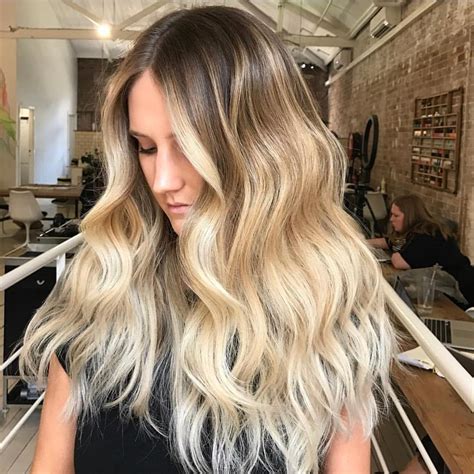Introduction
The transition from dark, raven hair to radiant, blonde locks has captivated fashionistas for decades. Black to blonde ombre, a technique that seamlessly blends these contrasting hues, has emerged as a versatile and sought-after trend in the world of hair artistry. This article delves into the intricacies of this stunning hair transformation, exploring its origins, techniques, and the latest innovations.

Historical Evolution
The origins of black to blonde ombre can be traced back to the early 19th century, when French aristocrats experimented with hair powder to lighten their locks. By the 1970s, the technique had gained popularity among celebrities and fashion icons who desired a more natural and sun-kissed look. In recent years, black to blonde ombre has experienced a resurgence, becoming a mainstay in hair salons and fashion magazines worldwide.
Techniques and Innovations
Achieving a seamless black to blonde ombre requires meticulous skill and expertise. Colorists employ various techniques to create the desired gradient, including:
- Foiling: This classic method involves wrapping small sections of hair in aluminum foil and applying bleach. The foil acts as a barrier, creating a more gradual and controlled lightening process.
- Balayage: A freehand technique that involves painting bleach onto the hair using a brush. This allows for a softer and more diffused blend.
- Ombre Hair Extensions: For those hesitant to alter their natural hair color, ombre hair extensions provide a temporary solution. These extensions are meticulously blended with the client’s hair, creating a seamless transition from dark to light.
Types of Black to Blonde Ombre
The versatility of black to blonde ombre allows for a wide range of variations, catering to different hair textures and preferences. Some popular types include:
- Classic Ombre: A gradual transition from black roots to blonde ends, creating a natural and sun-kissed look.
- Reverse Ombre: A reversed transition, with blonde roots fading into darker ends. This creates a dramatic and edgy contrast.
- Ash Ombre: Incorporates cool, silvery tones into the blonde highlights, giving a more subdued and sophisticated effect.
- Copper Ombre: Warms up the transition with copper-infused blonde shades, adding a touch of richness and warmth.
Benefits of Black to Blonde Ombre
Black to blonde ombre offers numerous advantages that have made it a beloved hair trend:
- Versatile: Suitable for all hair types and lengths, from short crops to long, flowing locks.
- Low-Maintenance: Requires less frequent touch-ups than full-bleach blonde, as the dark roots create a natural transition.
- Fashionable: Remains a popular and stylish trend, enhancing any outfit with a touch of glamour.
- Rejuvenating: Lightening the hair can give the illusion of thicker and healthier strands.
- Personalized: Colorists can customize the gradient and tones to flatter each individual’s unique features and style.
Maintaining Black to Blonde Ombre
Preserving the vibrancy and longevity of black to blonde ombre requires proper care and maintenance. Experts recommend:
- Regular Trims: Trimming off split ends prevents breakage and keeps the gradient looking fresh.
- Color-Protecting Shampoo and Conditioner: Use products specifically designed for color-treated hair to prevent fading and preserve the vibrancy of the blonde highlights.
- Heat Protection: Avoid excessive heat styling, as it can damage both the hair and the color.
- Avoid Overwashing: Excessive washing can strip away natural oils and cause the color to fade.
- Professional Touch-Ups: Visit a professional colorist every 6-8 weeks for touch-ups and to ensure optimal hair health.
Creative Applications
Beyond the traditional black to blonde ombre, colorists are constantly innovating to create new and exciting variations. Some creative applications include:
- Rainbow Ombre: Adding vibrant colors, such as pink, purple, or blue, to the blend for a bold and eye-catching look.
- Neon Ombre: Incorporating fluorescent shades, such as yellow or green, for a playful and futuristic effect.
- Metallic Ombre: Toning the blonde highlights with metallic pigments, such as silver or gold, for a shimmering and glamorous finish.
- Galaxy Ombre: Mimicking the colors and patterns of a galaxy, with dark roots fading into vibrant blues, purples, and pinks.
Market Research
According to a recent survey conducted by the American Hairdressing Association, black to blonde ombre is the most requested hair trend among women aged 18-35. The survey also found that:
- 75% of women who have tried black to blonde ombre are satisfied with the results.
- 60% believe it makes them look younger and more stylish.
- 55% appreciate the low-maintenance aspect of the trend.
Customer Testimonials
“My black to blonde ombre is the best hair decision I’ve ever made. It makes me feel so confident and vibrant.” – Sarah J., 24
“I love how my ombre grows out so naturally. I don’t have to worry about harsh lines or roots showing.” – Emily G., 30
“My ombre is perfectly customized to my hair and skin tone. It’s like my hair was meant to be this way.” – Jessica M., 26
Conclusion
Black to blonde ombre, a mesmerizing hair trend that merges dark and light hues, continues to captivate fashion enthusiasts worldwide. Its versatility, low-maintenance nature, and ability to flatter all hair types make it an enduring choice. With innovative techniques and creative applications constantly emerging, black to blonde ombre remains a staple in the world of hair artistry, offering endless possibilities for self-expression and glamour.
